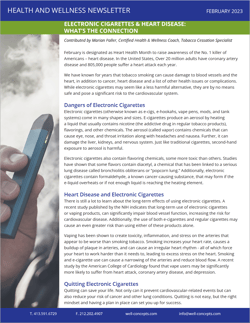ELECTRONIC CIGARETTES & HEART DISEASE: WHAT'S THE CONNECTION?
Contributed by Marian Paller, Certified Health & Wellness Coach, Tobacco Cessation Specialist
February is designated as Heart Health Month to raise awareness of the No. 1 killer of Americans – heart disease. In the United States, Over 20 million adults have coronary artery disease and 805,000 people suffer a heart attack each year.
We have known for years that tobacco smoking can cause damage to blood vessels and the heart, in addition to cancer, heart disease and a list of other health issues or complications. While electronic cigarettes may seem like a less harmful alternative, they are by no means safe and pose a significant risk to the cardiovascular system.
Dangers of Electronic Cigarettes
Electronic cigarettes (otherwise known as e-cigs, e-hookahs, vape pens, mods, and tank systems) come in many shapes and sizes. E-cigarettes produce an aerosol by heating a liquid that usually contains nicotine (the addictive drug in regular tobacco products), flavorings, and other chemicals. The aerosol (called vapor) contains chemicals that can cause eye, nose, and throat irritation along with headaches and nausea. Further, it can damage the liver, kidneys, and nervous system. Just like traditional cigarettes, second-hand exposure to aerosol is harmful.
Electronic cigarettes also contain flavoring chemicals, some more toxic than others. Studies have shown that some flavors contain diacetyl, a chemical that has been linked to a serious lung disease called bronchiolitis obliterans or “popcorn lung.” Additionally, electronic cigarettes contain formaldehyde, a known cancer-causing substance, that may form if the e-liquid overheats or if not enough liquid is reaching the heating element.
Heart Disease and Electronic Cigarettes
There is still a lot to learn about the long-term effects of using electronic cigarettes. A recent study published by the NIH indicates that long-term use of electronic cigarettes or vaping products, can significantly impair blood vessel function, increasing the risk for cardiovascular disease. Additionally, the use of both e-cigarettes and regular cigarettes may cause an even greater risk than using either of these products alone.
Vaping has been shown to create toxicity, inflammation, and stress on the arteries that appear to be worse than smoking tobacco. Smoking increases your heart rate, causes a buildup of plaque in arteries, and can cause an irregular heart rhythm - all of which force your heart to work harder than it needs to, leading to excess stress on the heart. Smoking and e-cigarette use can cause a narrowing of the arteries and reduce blood flow. A recent study by the American College of Cardiology found that vape users may be significantly more likely to suffer from heart attack, coronary artery disease, and depression.
Tips to Encourage Health and Well-being
Quitting can save your life. Not only can it prevent cardiovascular-related events but can also reduce your risk of cancer and other lung conditions. Quitting is not easy, but the right mindset and having a plan in place can set you up for success.
STEP 1: IDENTIFY YOUR WHY The most important aspect of quitting is identifying WHY you want to quit. Is it to save money? Is it for your health? Something else? These reasons will help determine your intrinsic or internal motivation.
STEP 2: TIMING Next is all about timing and choosing a start and end date. What day would you like for your plan to start and what is your desired quit date? Choosing these key dates can ultimately help with planning and making the commitment.
STEP 3: YOUR QUIT PLAN Think about how you want to quit. Do you want to quit cold turkey? Put the e-cigarette down and walk away? Or do you want to gradually decrease how much you are using each day or week?
STEP 4: IDENTIFY TRIGGERS What are your main triggers that lead to smoking or vaping? Is it for social reasons? Stress? With your morning coffee? The answer to this question will give you an idea of where and when you are most likely to use so you can come up with a plan of action of what you will do instead of using the electronic cigarette.
STEP 5: OVERCOMING WITHDRAWAL Have a plan in place of what you will do to overcome withdrawal and cravings. Withdrawal and cravings are real and when you are trying to quit, they can feel more intense. What can you do in these situations? Consider taking a deep breath, meditating, texting a quit smoking program, or taking a walk outside.
Quit Resources
For more help you on your journey to quitting, check out the following resources:
Remember – it can take 8-11 attempts to quit for good, so don’t get frustrated if you have attempted to quit in the past but relapsed or are hesitant to try quitting. Each attempt is a learning experience. Having a plan and a support system are great places to start setting yourself up for success.
If you are interested in starting a group program for additional support, contact Wellness Concepts to learn about our NEW 30 Days To Becoming Nicotine-free Challenge by going to https://info.well-concepts.com/contact-us for more info.
What strategies will you use to quit or help someone else quit?

Marian Paller is a Certified Health & Wellness Coach and a Tobacco Cessation Specialist. She has guided hundreds of people in their journey to becoming, and staying nicotine-free. Marian leads the 30 Days to Becoming Nicotine-free Challenge.


